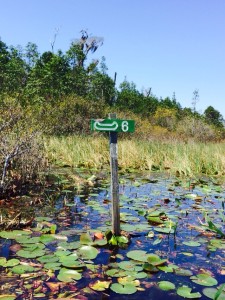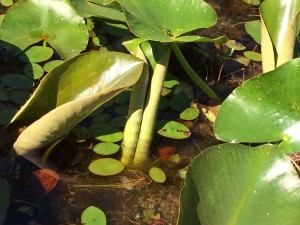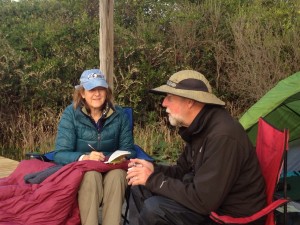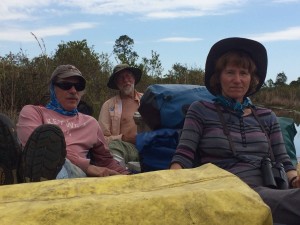It’s still early spring, botanically speaking, in the Okefenokee Swamp. I had hoped to see legions of blooming pitcher plants, as I have on visits past, but very few are flowering on the last weekend in March.
Jeff and I are paddling with one of my oldest swamp companions, Bob Knight, and his wife, Debbie Segal, from the Florida Springs Institute in Gainesville. We four are all activists and lovers of nature–three scientists and one writer—eager for wilderness renewal.
 It is eight miles to Bluff Lake, our overnight destination, so there is plenty of time to muse in the bow seat of the canoe where I paddle. Since the pitcher plants aren’t ready to be admired, I focus on the leaves of spatterdock and water lily that glimmer in shades of cream and garnet under the surface of the black water swamp. Some are so deep in the muck, they only glint, like deep ocean sunfish. Others emerge, like thin curled tongues, or funnels, or straws.
It is eight miles to Bluff Lake, our overnight destination, so there is plenty of time to muse in the bow seat of the canoe where I paddle. Since the pitcher plants aren’t ready to be admired, I focus on the leaves of spatterdock and water lily that glimmer in shades of cream and garnet under the surface of the black water swamp. Some are so deep in the muck, they only glint, like deep ocean sunfish. Others emerge, like thin curled tongues, or funnels, or straws.
And many resemble ancient scrolls, rolled toward the center line of the leaf. If they are scrolls, then this is an especially wise place: so many new leaves are unfolding.
The next morning, at sunrise, we listen from our sleeping bags to the unlikely intermingle of sandhill cranes bugling and the zingy calls of parula and prairie warblers. Actually it’s not so unlikely: these songs tells you that you are here in the Okefenokee Swamp, and it’s early spring.
I can see that my old friend Bob is carrying more weight on his shoulders than he ever did as a 24-year-old, when I knew him so well. We settle into camp chairs to talk, and he tells me what threatens the watery jewels that every north and central Floridian loves: Wakulla, Silver, Poe, Ginny, Ichetucknee, so many more.
“Imagine your body trying to get by with only 75% of its blood supply,” he says. “You begin to weaken, right?” By any measure, that’s what is happening to our springs. Anything that uses groundwater is competing with Florida springs for their water. And that competition is getting extremely fierce.
Bob has just published a new book called Silenced Springs: Moving from Tragedy to Hope, which everyone who has ever loved a spring should buy and study.
On the way out of the swamp, Jeff and I take the lead in our canoe. When Bob and Debbie catch up, their faces are pained.
“I just got a call on my cell from a friend in town,” said Bob. “The Florida House of Representatives just passed a bill allowing ‘low impact’ agriculture in our state parks.”
“Come on,” I say, “That’s unthinkable. Nobody could be that evil!” But their expressions tell me it is true. It’s been such an awful time under our current political leadership. At every level, from the governor on down, politicians are working to dismantle every possible protection of our water, land and vulnerable residents.
“That could mean citrus groves in the Kissimmee Prairie,” Bob says. “But you know what? It’s really just a ploy. Politicians are diverting the attention of nonprofits and nature lovers from the really big thievery that’s going on, like the handing over of our groundwater and springs to Big Ag.”
My eye rests on tiny blue darters flitting above the new leaves of the lilies. A pig frog croaks. How could such beauty and such human darkness exist in the same world?
 What keeps you going on the trail, from mile 8 to mile 7, from mile 3, to mile 1? When your shoulders ache, your lower back is tight and your skin burns? What keeps you moving past alligators, and over peat blowups in your watery trail? I have no doubt we will make it back to Kingfisher Landing, where we will offload our gear and drive home. But what moves us forward when the forces of greed so relentlessly plunder our planet?
What keeps you going on the trail, from mile 8 to mile 7, from mile 3, to mile 1? When your shoulders ache, your lower back is tight and your skin burns? What keeps you moving past alligators, and over peat blowups in your watery trail? I have no doubt we will make it back to Kingfisher Landing, where we will offload our gear and drive home. But what moves us forward when the forces of greed so relentlessly plunder our planet?
Debbie says: “What motivates me is that I know I can contribute, and that I can make a difference. I have an environmental science background, and I know how to engage on these issues. So I do!”
“I do it for my students, for the young people,” says my husband, Jeff. “The students I teach are so enthusiastic. I can’t walk away from them. If they’re going to do it, then so will I.”
Bob picks up his paddle, says: “I keep going because it’s the right thing to do. Also, I’m surrounded by wonderful people fighting for the springs just like I am. It’s so gratifying when 1500 people show up at a rally, rise up on behalf of the springs.”
Sometimes you are pushed to paddle harder by the threat of a black storm on the horizon. Sometimes you’re simply supported by a strong companion in the stern of your boat. But most of all, for me, it’s the company of the tree swallows in the free air overhead, and the common yellowthroat warblers singing in the brush. Their presence urges me forward.
Share On:





Potent and poetic.
Thanks for the inspiration, Sue! And the perspiration! And the great book suggestion.
Beautifully written, thank you. Brandy
Wonderful story–so much said in so few words. And, truly, low-impact agriculture in state parks! Rick
Wow, that means a lot from Rick Knight! I keep up with your excellent wildlife work out West. Come help us save Florida!
This is a great essay, Sue. You put me right there into the beauty, and it breaks my heart to remember how badly the legislature is being run these days. I am going to post this on my Fb if I can figure out how.
Well done! And it moves my heart. You mention knowing Bob as a young man,
and you speak of the weight he now feels on his shoulders. The photo of the
two of you, along with your words, shows the arc of a life; you can almost
see that weight in his profile, and the encouragement in your smile. You
all hold the memory of how the natural places were, and what they are
becoming. Young people rely on the vision and guidance of elders– whether
they are aware of it or not. And as Jeff said, their awakening and
enthusiasm is also our fuel for going on. Thank you for taking notes on all
the interweaving threads! You help create the fabric of hope.